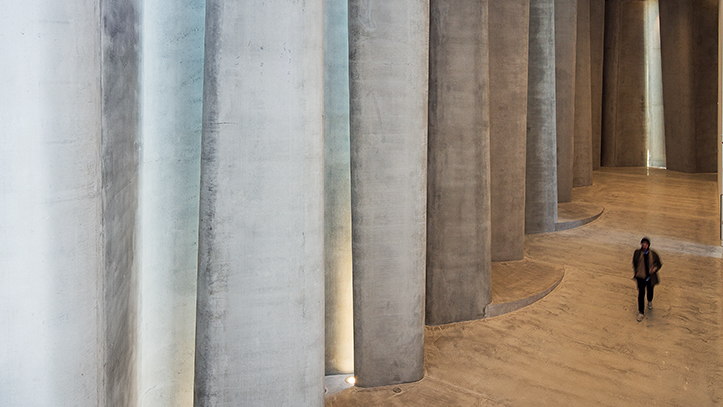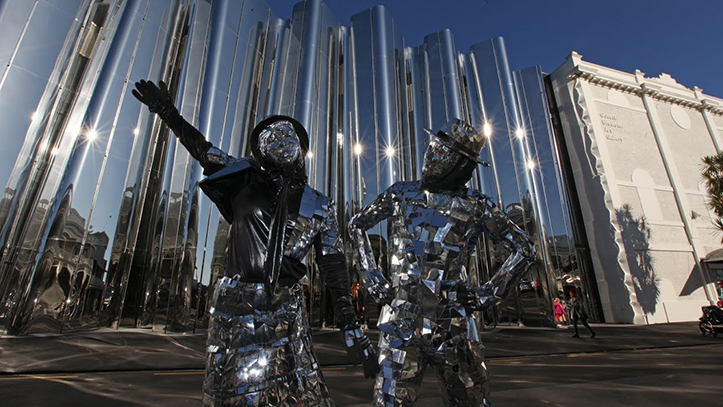The Artist
Len Lye (1901–1980) is arguably one of the twentieth century’s most original artists; a one-man art movement spanning several countries and multiple media over a lifetime and beyond. As a New Zealander practicing in London during the pre-war years, and then a key figure in the post-war New York avant-garde art scene, Lye mapped a unique course through Modernism.
Lye spent his career pursuing an ‘art of movement’, a theory he initiated before he left Aotearoa New Zealand in 1924. He wanted to affect people physically and emotionally, so that art became a full body experience. Whether this was with flashing, dancing cinematography, or thunderous, oscillating metallic sculptures, his work stimulated the senses and was unforgettable.
He was a pioneer of experimental film and kinetic sculpture, and his practice included painting and poetry, among numerous other media. The intensity, energy and excitement of his work were matched by a gregarious and restless personality; British poet Alistair Reid once described him as ‘the least boring person who ever existed’.
Part of his difference was forged during a difficult childhood. His father died prematurely, which led to a lot of moving around and instability for Lye and his brother. But the experience built a strong independence in the young Lye, and it also meant he saw more of his country than he might have otherwise.
Significantly, he spent a year living in a lighthouse on Cape Campbell, at the eastern entry to the Cook Strait, while his stepfather was the lighthouse keeper. Lye saw firsthand the great mechanised clockworks and the lantern’s sublime flashing beams of light penetrating the darkness and the storms. Light, projection, movement and mechanisation were pitted against the full force of nature, powerful symbols that forecast the artist’s attraction to film projection and kinetic sculpture.
The Len Lye Centre
The Len Lye Centre is an international destination for experimental film and kinetic art. It houses the collection and archive of Len Lye, one of the most original artists of the twentieth century. Pioneer filmmaker, sculptor, painter and poet, his extraordinary body of work gives us a unique view into Modernism and offers a rich vein for inspiration and insight.
Led by a growing interest locally and internationally in his work, the centre opened in 2015 adjoining the Govett-Brewster Art Gallery. This state of the art facility houses Lye’s archive, display galleries, an education centre, and a 62-seat cinema. Designed by New Zealand architect Andrew Patterson, the building is a contemporary interpretation of the essence of Lye and a major cultural destination on the Pacific Rim.
Like a Lye sculpture, the shimmering stainless steel façade is a striking and provocative expression of movement. The curtain-like exterior is seemingly fluid as the curved steel reflects and transmits light, activating the spaces within and without. It is a modern day temple, reinterpreting Lye’s fusion of ancient and modern concepts, and his proposition for a ‘temple of art’.
A colonnade, vestibule and inner sanctum are each expressed in new form to provoke an unworldly experience and to challenge the dominance of pure modernism in contemporary architecture. In this temple, art is now the deity, the archive and galleries the sacred spaces. Scale, materials, light and atmosphere are composed as in a film to activate the senses and incite a poetic dimension.
42 Queen Street
New Plymouth, 4310
Aotearoa New Zealand
Len Lye's Work
Though best known internationally as a film-maker, Lye used many different forms of expression, including textiles, painting, drawing, static and kinetic sculpture. He was also a writer of poetry, fanciful letters, stories and utopian theoretical texts dealing with the relationship between art, individuality, and happiness.
The Govett-Brewster holds the collection of work by Len Lye, on behalf of the Len Lye Foundation. The collection includes Lye's pioneering kinetic sculptures, photograms and experimental films, and a substantial archive.
The Len Lye Collection and Archive consists of all non-film works in Lye’s possession at the time of his death in 1980, as well as several items that have been gifted or acquired by the Foundation since. This body of work is extended by Len Lye works in the Govett-Brewster Art Gallery. The New Zealand Film Archive is the repository of Lye’s film prints that are owned by the Len Lye Foundation, and viewing prints are also in the Collection at the Govett-Brewster.
“A definite wow factor and excellent experience”
5 of 5 stars Reviewed 14 September 2015 NEW
Mindboggling architecture and a great learning experience. We were met by a very helpful lady (volunteer?) .. a bit surprised by both free entry and permission to take photos (no flash). We're very glad we visited and have learned a great deal
- Merlin Blaise
“Super Duper”
5 of 5 stars Reviewed 13 September 2015 NEW
Well worth a visit. We loved the architecture of the Len Lye addition to this gallery. Not to mention the exhibition as well because it is very interesting.
- 631Sue
“New Len Lye gallery is stunning”
5 of 5 stars Reviewed 12 September 2015 NEW
This gallery is a must see. The new gallery itself is a stunning space - and the Len Lye galleries simply wonderful. The 'fountain' exhibition is simply beautiful on many levels - sight, sound and emotion. The Lye gallery merges almost seamlessly with the former Brewster gallery, plus there's a arty little gift shop. Oh and it's free. What more...
- LynneN
“Confounding, energising and outstanding”
5 of 5 stars Reviewed 3 September 2015
I have a particular love for the Govett-Brewster: it opened just a few months before I was born so I've grown up with the gallery and its outstanding, challenging and sometimes head-scratching exhibitions. And it's FREE (although closed on Tuesdays and Christmas Day). It's adjacent to the new wow-magnet Len Lye Centre - but while the LLC has the whizz-bang...
- KiwiA














